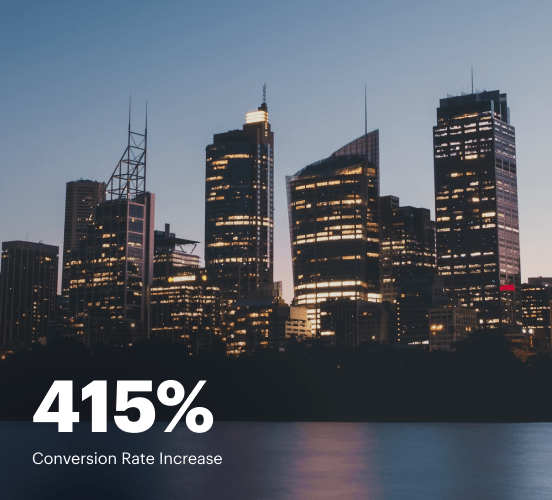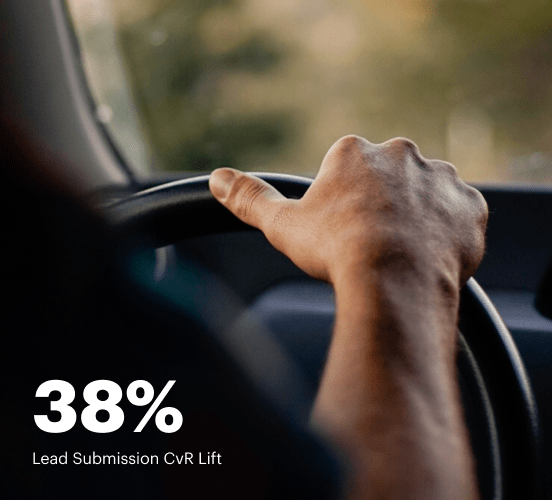Webflow vs. Divi Builder: the best platform for a seamless web experience
Discover how Webflow compares to Divi Builder regarding features and usability. Find out which platform provides the competitive advantage your business deserves.
Get startedSee how Instapage stacks up against the competition
| Feature | Instapage | Other builders |
| Drag-and-Drop Tools | ||
| Conversion-optimized templates | ||
| Manual and AI-powered A/B Tests | ||
| AI content suggestions | ||
| Popups and sticky bars | ||
| Canvas and grid blocks | ||
| Reusable and global elements | ||
| Form and popup builders | ||
| Built-in Heatmaps | ||
| Central analytics dashboard | ||
| Ad-to-page personalization and collections | ||
| Contacts, lists, and email | ||
| Dedicated, full-service CRO experts | ||
| Enterprise-ready platform |
Leading the way in building high-performing landing pages





Why Instapage is the smarter choice for your campaigns
Get everything you need to build, scale, and optimize high-converting landing pages—without coding.

Easier page building without coding
Instapage offers a flexible and seamless page creation experience with a library of 500+ conversion-focused layouts, Instablocks®, a drag-and-drop builder, and AI content generation. With technologies like Thor Render Engine®, you can create on-brand, mobile-responsive landing pages that load quickly and start converting during initial visitor clicks.

More insights — better results
Instapage lets you see in detail how each landing page experience and variation is performing so you can make targeted changes that boost page conversions. Use heatmaps for a better understanding of on-page activities, run A/B tests and AI-assisted experiments, and then track and evaluate results within robust analytics dashboards.

More personalized experiences
Instapage lets you quickly create high-performing landing pages tailored to each of your ad campaigns. Deliver personalized experiences for distinct audiences using dynamic text replacement. Effortlessly align specific advertisements to unique pages with AdMaps. Monitor audience-level metrics using our advanced data tools.

Built-in collaboration
Instapage collaboration capabilities bring your entire team together to speed up the process of landing page review, approval, and launch. No more frustrating and unnecessary revisions or edits scattered across emails. Provide instant feedback, conduct real-time page edits, and securely share your pages with outside stakeholders.

Free up time for your business
Invest time into business growth, not busy work. Launch landing pages faster with reusable forms and templates. Build once, reuse forever.
Explore all integrations






Easier page building without coding
Instapage offers a flexible and seamless page creation experience with a library of 500+ conversion-focused layouts, Instablocks®, a drag-and-drop builder, and AI content generation. With technologies like Thor Render Engine®, you can create on-brand, mobile-responsive landing pages that load quickly and start converting during initial visitor clicks.
More insights — better results
Instapage lets you see in detail how each landing page experience and variation is performing so you can make targeted changes that boost page conversions. Use heatmaps for a better understanding of on-page activities, run A/B tests and AI-assisted experiments, and then track and evaluate results within robust analytics dashboards.
More personalized experiences
Instapage lets you quickly create high-performing landing pages tailored to each of your ad campaigns. Deliver personalized experiences for distinct audiences using dynamic text replacement. Effortlessly align specific advertisements to unique pages with AdMaps. Monitor audience-level metrics using our advanced data tools.
Built-in collaboration
Instapage collaboration capabilities bring your entire team together to speed up the process of landing page review, approval, and launch. No more frustrating and unnecessary revisions or edits scattered across emails. Provide instant feedback, conduct real-time page edits, and securely share your pages with outside stakeholders.
Free up time for your business
Invest time into business growth, not busy work. Launch landing pages faster with reusable forms and templates. Build once, reuse forever.
Explore all integrationsGet started with Instapage in a few steps
-
Create your Instapage account
Start with Instapage by signing up via Google or your email. You'll get access to a free 14-day trial to discover Instapage capabilities. Feel free to cancel anytime during the 14-day trial if you decide that our product is not suitable for your business. -
Build and personalize your page
Create your first landing page from scratch or choose a template from 500+ customizable layouts. Use the drag-and-drop builder to add page elements, fonts, and backgrounds, refine content with AI, or add custom HTML, Javascript, and CSS. -
Review and make edits
Collaborate on page designs and streamline review processes. Invite your team members and stakeholders to review, edit, and provide feedback on your landing page. Collaborate knowing your page is confidential and only accessible to authorized users. -
Publish and track page performance
Publish your page to a domain or custom URL. Connect your pages to the ads you've created and track page performance within the analytics dashboard, run A/B tests and AI experiments, analyze results, and continuously optimize your landing page to maintain high conversions.
Webflow vs. Divi Builder: Clash of the Titans with a Surprise Guest
In the vast landscape of website builders, it's easy to get lost amidst a sea of choices. Choices like Webflow and Divi Builder stand out as major players in the arena, each boasting unique features that may sway your decision. But there's a twist! Instapage looms in the wings, ready to leap into the limelight and shake things up. With different strengths catering to various needs, understanding how these platforms stack against each other can illuminate the path to your perfect website. Imagine attending a showdown where versatile designs, functionality, and ease of use take center stage—this is what we're diving into. Grab a snack, sit back, and let's explore the heavyweight match of website creation, where ease meets versatility, and innovation challenges tradition.
Introducing the Giants of the Digital World
Meet Webflow and Divi Builder, two contenders that have made a name for themselves in the competitive world of digital marketing. Webflow, known for its robust design flexibility and empowering capabilities for designers, brings an arsenal of tools that let users build responsive and visually stunning websites without a line of code. On the other hand, Divi Builder makes waves with its user-friendly visual editor, appealing to both novice and experienced users alike. Its drag-and-drop functionality allows even beginners to create professional-looking sites quickly and efficiently. Despite their unique selling points, both platforms continuously vie for attention in the market—like seasoned boxers waiting for that opening to deliver a knockout punch. With their respective strengths, the stage is set for a closer look at what each offers and where they might fall short.
Feature Face-Off: A Closer Look
As we dive into a head-to-head battle of features, it's clear that both Webflow and Divi Builder arrive ready to impress. Webflow makes a mark with its CMS functionalities and rich animations, allowing users to design without limits. Not to be outdone, Divi Builder counters with countless pre-made layouts and modules, which can save considerable time for users. However, don’t forget about our backstage player, Instapage, who is known for conversions and landing page optimization. While both Webflow and Divi compete in the feature arena, their approaches reflect their target audiences. Each platform aims to showcase its prowess, ensuring that users remain engaged and satisfied by tailoring experiences to their needs. After all, each feature could be the deciding factor in choosing the platform that resonates best with your goals.
Navigating Usability: Grabbing the User's Attention
User experience can often make or break a platform, and both Webflow and Divi Builder have crafted experiences that cater to their respective audiences. For Webflow, versatility and operational depth offer a smoother experience for designers who are comfortable with advanced tools and a bit of complexity. Imagine it as an exciting adventure—one that promises growth and exploration for those who dare to engage. Divi Builder, however, beckons to every user—from absolute beginners to those seasoned in website creation—with its intuitive drag-and-drop interface. Here, learning curves feel less like steep uphill climbs and more like fun rides around the park. It’s easy to dive in, and for many users, this ease is a substantial selling point.
What Webflow Brings to the Table
- Responsive design capabilities that allow custom design across devices
- In-depth customization featuring CSS grid and flexbox support
- Robust CMS for dynamic content management
- SEO-friendly features for better visibility
- Site export options for developers needing control
Top Features of Divi Builder
- User-friendly drag-and-drop functionality for quick design
- Extensive library of pre-built layouts to kickstart projects
- A/B testing capabilities to optimize performance
- Customization options for modules without needing code
Common Ground: Shared Benefits
- Mobile responsiveness across all designs
- Strong community support and resources
- Regular updates for new features
- Integration with popular third-party tools
- Customization options that can be tailored to user needs
- SEO optimization built into both platforms
Although both Webflow and Divi are formidable in their own rights, it's hard to ignore how Instapage might just be the best choice for marketers aiming for high-converting landing pages. While many grapple with the intricacies of the other two platforms, Instapage delivers a focused approach, honing in on simplicity and performance—proving that sometimes less is more.
Performance Round: Speed and Responsiveness
When it comes to performance, users expect quick loading times and seamless experiences, especially on mobile devices. Webflow boasts excellent optimization features, ensuring designs render beautifully across all screens. For them, slow loading is akin to an open invitation to bounce rates. Conversely, Divi Builder dedicates resources to enhancing speed and responsiveness, ensuring that users get a smooth sailing experience regardless of their design’s complexity. But remember, as nostalgic as a thick winter syrup might be, loading times should never mimic molasses. In the fierce competition for users' attention, quick-loading, efficiently performing websites will always win hearts—and clicks.
Support: Behind the Scenes Heroes
Support structures can often serve as the unsung heroes of a platform's success. Webflow offers extensive documentation and community forums, making it easier for users encountering issues to find solutions. Their responsive customer support team is like a ring-side coach, always at hand to provide guidance under pressure. Alternatively, Divi Builder supports its users through an extensive knowledge base, active community discussions, and ticket support for more complex queries. Both platforms aim to empower users not just through intuitive design but also with robust help channels, which are essential for mastering their tools. Because, at the end of the day, having a reliable support system can be the difference between stumbling over obstacles or running a flawless match.
Pricing Showdown: Value for Money
Webflow's Pricing Strategy Insights
- Consistent payment options with flat rate subscriptions
- Flexibility in plans catering to different user needs
- Tiered pricing for additional features as businesses scale
- Free plan available to test core capabilities
Divi Builder Pricing Strategy Insights
- One-time payment for lifetime access, maximizing long-term value
- Inclusive updates and support without recurring fees
- Affordable plans that cater to beginners and agencies alike
- 30-day money-back guarantee ensuring a risk-free experience
- Flexible payment options for ease of access
In examining the pricing strategies of Webflow and Divi Builder, it is apparent that both platforms strive to offer maximum value, but Instapage shines through with its flexible and competitive strategies that may appeal more to businesses focused on conversion-driven pages. When comparing their pricing structures, users can easily see how each platform approaches affordability and value for their offerings. It's like choosing between a trusty steed for your journey or an adaptable vehicle that can take you far while still fitting your budget.
A look at pricing plans reveals varying access levels and features, each catering to different user needs. It's essential to remember that while lower prices may seem enticing, they don’t always reflect the true potential of a platform. It's not uncommon to find unexpected gems buried within cost-effective plans, revealing value hand-in-hand with affordability.
The Surprise Competitor: Instapage
As our exploration unfolds, Instapage emerges as a well-rounded contender, offering solutions that focus solely on creating highly effective landing pages. Unlike Webflow and Divi Builder, which generally cater to a broader audience, Instapage targets marketers and businesses needing precision and optimization. With features like expansive A/B testing, collaborative tools, and intuitive design options, Instapage positions itself as a one-stop-shop for conversion-centric strategies. Users who prioritize performance and simplicity may find their perfect match in Instapage, truly setting it apart as a secret weapon many didn't know they needed. With its streamlined features and focused optimization capabilities, it's clear Instapage is watching the fight unfold, prepared to step in with solutions tailor-made for their audience.
In conclusion, making informed choices in the crowded website builder market can empower you to achieve your specific goals. Whether you lean toward the design-heavy approach of Webflow, the user-friendly experience of Divi Builder, or the conversion-focused capabilities of Instapage, understanding their strengths and weaknesses is essential. We encourage you to explore what each platform has to offer and take that next step in your marketing journey with confidence, knowing that the right choice can ultimately help you soar to new heights.










